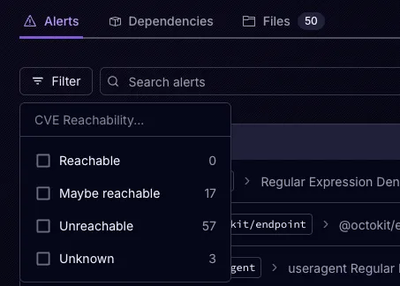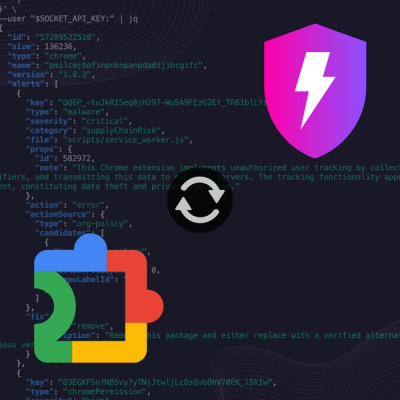
Product
Announcing Precomputed Reachability Analysis in Socket
Socket’s precomputed reachability slashes false positives by flagging up to 80% of vulnerabilities as irrelevant, with no setup and instant results.
eslint-plugin-styled-components-a11y
Advanced tools
This is a work in progress for linting styled components according to the rules outlined in eslint-plugin-jsx-a11y.
This is a work in progress for linting styled components according to the rules outlined in eslint-plugin-jsx-a11y.
It handles all 4 methods styled components uses to create components. All of these would show the error
Visible, non-interactive elements with click handlers must have at least one keyboard listener.
const Div = styled.div``;
<Div onClick={() => null}/>
const Div = styled.div.attrs({ onClick: () => null})``;
<Div />
const Div = styled.div.attrs({ onClick: () => null})``;
const StyledDiv = styled(Div)``;
<StyledDiv />
const ButtonAsDiv = styled.button``;
<ButtonAsDiv as="div" onClick={() => null} />

a working repo can be found at https://github.com/brendanmorrell/styled-components-a11y-example which has a file illustrating the linting rules in action for the above four styled component types the library is currently capable of handling
This library is currently a work in progress. At the moment, some of the rules do not fire in all cases, and there is some debugging and testing still to be done.
Install as a dev dependency using yarn add eslint-plugin-styled-components-a11y or npm i eslint-plugin-styled-components-a11y --save-dev and
add styled-components-a11y to the plugins section of your .eslintrc configuration file. You can omit the eslint-plugin- prefix:
{
"plugins": [
"styled-components-a11y"
]
}
Enable the recommeded ruleset or the strict ruleset. Add plugin:styled-components-a11y/recommended or plugin:styled-components-a11y/strict in extends:
{
"extends": [
"plugin:styled-components-a11y/recommended"
]
}
Alternatively, you can configure individual rules under the rules section.
{
"rules": {
"styled-components-a11y/rule-name": 2
}
}
Contributions are very welcome, as I don't have a lot of free time to work on this currently. My personal todo list is in Todo.md. I will try to make this more intelligible to other contributors, but if you'd like to start before I get around to that, let me know, and I can tell you what still needs work. Thanks!
Note: Someone asked how to contribute. I'll drop the response here in case it's useful (can clean it up/add more later depending on interest)
I would absolutely love some help as I only get around to working on this in my spare time (of which I have little at the moment). there is a Todo.md in the repo with a list of things I still want to look into/work on, but I wasn't intending for others to read that, so it might not make a ton of sense.
Here are the broad strokes in order of priority:
const clickKeyDown = makeStyledTestCases({
tag: 'a',
attrs: '{ onClick:() => 0, onKeyDown: foo }',
props: 'onClick={() => 0} onKeyDown={foo}',
children: 'some text'
});
would create an array of objects with the key 'code' having the following strings respectively
const FUNC = styled.a``;
const Component = () => <FUNC onClick={() => 0} onKeyDown={foo}>some text</FUNC>
const FUNC = styled.a.attrs({ onClick:() => 0, onKeyDown: foo })``;
const Component = () => <Component>some text</Component>
const FUNC = styled.a.attrs({ onClick:() => 0, onKeyDown: foo })`; const Extended = styled(FUNC)`;
const Component = () => <Extended>some text</Extended>
const FUNC = styled.div.attrs({ onClick:() => 0, onKeyDown: foo })`; const Extended = styled(FUNC)`;
const Component = () => <Extended as="a">some text</Extended>
to test error cases, you add the errors parameter to makeStyledTestCases, which will pass if the correct error fires
See if you can add some more rules. When the rules error out, best bet is to log whatever the failing role is, and then take all those test cases, paste them into a project that is running eslint-plugin-styled-components-a11y, and just trace the code to see why it is either firing when it shouldn't or not firing when it should. The way i have been doing this (which is kind of painful) is to go into your node_modules and start by just getting the rule to fire. for this you either want to look in src/collectStyledComponentData.js (if the problem is with collecting the data for the styled component), or more frequently in the relevant parser file in src/nodeParsers. Look at src/ruleNameToTypeDict to see what parser goes with what rule. When you have the right file, i generally start out by just getting the linter to fire off with a hello world. Each parser file has a helper function in it called 'func'. it looks like this:
put the name of the rule in where the example says 'scope' (so it only runs once for that rule instead of on every rule) and call it with either the node you want to log (which is what eslint is parsing. it runs over every node in the code's abstract syntax tree and calls your lining rules), or anything else you want to log. immediately after you run fund (at first, at the top of the file), add a return statement, as sometimes the linter is erroring out, and thus won't log unless you short-circuit it before the error. For example, if i were testing the rule accessible-emoji i would have the following to start:
const func = inspectee => name.includes('accessible-emoji') && context.report(node, inspect(inspectee || node));
fund('hello world');
return;
When you reload your editor (this is necessary unfortunately), you should see hello world as an error on the styled component. Then you just work your way through the code until you can see where it is erroring out or not passing the correct data through.
the rule currently does not handle imports, only components defined within a single file. I would like to change from the current setup, where i create a dictionary with all the styled components names (eg, if the declaration is const Func = styled.div.attrs({foo:'bar'})``; the component dictionary i make looks like this { Func : { tag: 'div', attrs: {foo:'bar'} }), to keying off the name of the component and the filename, e.g. change Foo to '/users/brendan/components/Tab__Func'. Look to the eslint rule import/no-cycle for some guidance on how to possibly do this
there are a lot of edge cases in terms of both the function and arrow function syntax for attrs (e.g.,
styled.div.attrs(p => p.large ? ({foo:'bar', baz: p.small ? 1 : 2}))``;```
and just expressions in general for all the attributes and props, especially handling template strings with embedded expressions. This is pretty complex though, and no linter is perfect, so this should probably wait until the end
FAQs
This plugin adds the ability to lint styled components according to the rules outlined in eslint-plugin-jsx-a11y.
The npm package eslint-plugin-styled-components-a11y receives a total of 56,600 weekly downloads. As such, eslint-plugin-styled-components-a11y popularity was classified as popular.
We found that eslint-plugin-styled-components-a11y demonstrated a healthy version release cadence and project activity because the last version was released less than a year ago. It has 1 open source maintainer collaborating on the project.
Did you know?

Socket for GitHub automatically highlights issues in each pull request and monitors the health of all your open source dependencies. Discover the contents of your packages and block harmful activity before you install or update your dependencies.

Product
Socket’s precomputed reachability slashes false positives by flagging up to 80% of vulnerabilities as irrelevant, with no setup and instant results.

Product
Socket is launching experimental protection for Chrome extensions, scanning for malware and risky permissions to prevent silent supply chain attacks.

Product
Add secure dependency scanning to Claude Desktop with Socket MCP, a one-click extension that keeps your coding conversations safe from malicious packages.